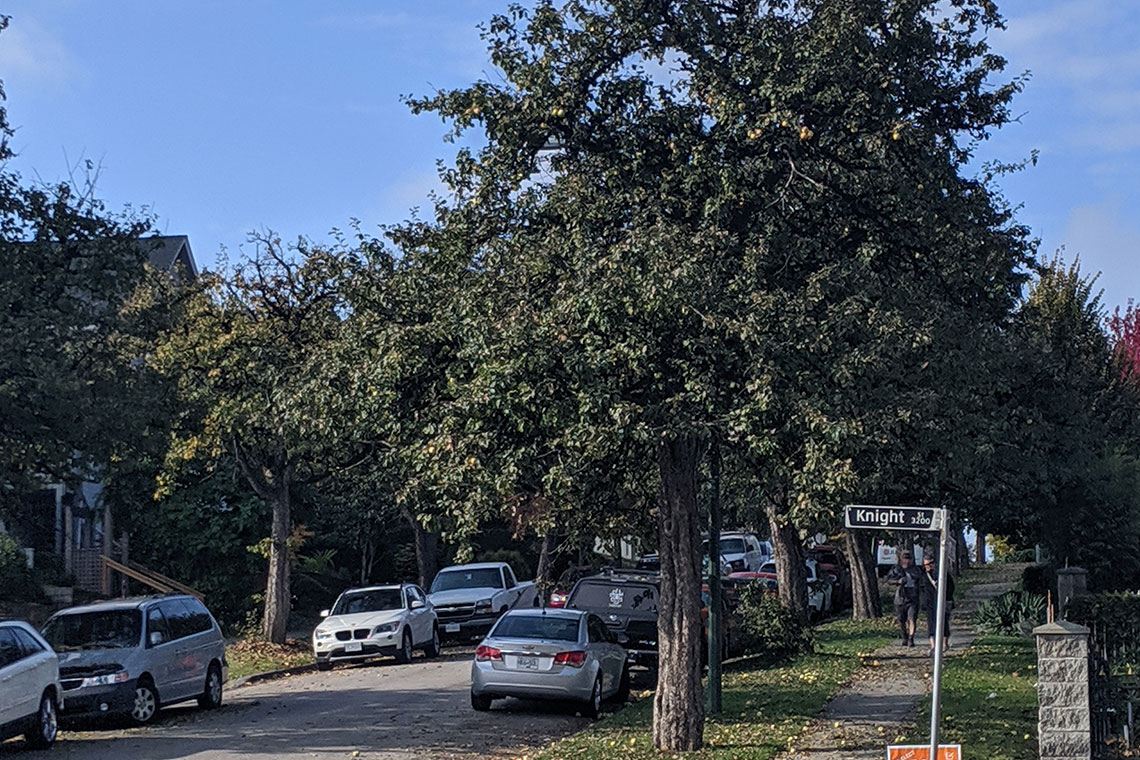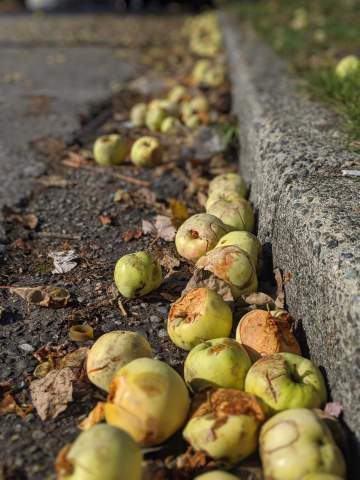
Harvesting The Urban Orchards
You see the most when you’re really looking.
Our journey started over two years ago when my wife Nathaly and I took a serious leap from home cider production to a fully-fledged cidery, using apples from city trees. The first promising tree we found was along Grandview Highway, back from the road with a heck of a lot of apples that seemed ready for picking at the end of August 2017. There are about seven trees on that stretch—a mix of yellow crab apples and red and green apples—but this one looked like the safest bet. Other trees overhung the busy road and picking them would surely have involved death-defying stunts.
The seed from an apple is a hybrid of its parents, like human babies. That Grandview tree likely grew from a discarded apple core, and we have no idea what kind it was; our best guess is a Baldwin cross. We picked about 80 pounds from that tree: enough to ferment our first 20 litres of 100% East Van Cider.
For the past three summers we’ve cycled up and down alleyways, mapping apple trees. Last year we picked 1,000 pounds of apples from about 25 trees throughout Vancouver, and this year it grew closer to 4,000 pounds. This has opened our eyes to the huge abundance of fruit growing just over our heads. This city has hundreds of trees and many urban orchards growing with no pesticides or pruning. Amazingly, many of these trees are heritage varietals—Winesaps, Cox’s Orange Pippins, Winter Banana—planted dozens of years ago by newcomers to the city.
One stretch of East 17th Avenue is lined with 15 apple trees. As far as I can tell, they are Gravensteins. The trees are completely unpruned and growing wild. In the autumn, Knight Street is lined with these apples; they fall to the pavement and roll down the hill to meet their fate. Along the way, they hit cars or roll through people’s yards. As far as I can tell, no one knows how this urban orchard got there. The City of Vancouver’s database of trees on public property lists the species as Malus pumila but has no indication of when they were planted. And that’s just one urban orchard we’ve visited.
There’s an ongoing project to rehabilitate the Copley Community Orchard, located beside the SkyTrain line just north of Trout Lake. A community group has been pruning and picking the older trees in the park and planting and nurturing new trees. The group hosts a pick-and-press in the fall and is always looking for help. Another local community group maintains a small orchard in China Park North.
One tree we’re especially fond of is on the way to our daughter’s school in East Vancouver. The tree is old and, up until this past year, was unpruned. The tenants of the property started taking care of the tree last year and it now grows a lot of fruit. We’ve been told it’s a Winesap apple tree, and this past year we picked close to 500 pounds from it and helped clean up fallen apples from their yard. We’ve also found and picked a gigantic tree in the back yard of a convent in New Westminster, and an absolute giant of a tree in the back yard of a stately home in Shaughnessy, among others.

The theme here is food waste and food security inside of our city. Most of the fruit from these apple trees, as well as plums, quince, pears, grapes and more, typically goes into the dumpster. Fallen fruit attracts rats and racoons in the city, and bears on the North Shore. It’s a shame that it creates such a problem, waste and otherwise, but a family (or group of families) can only eat so many apple pies and bottles of apple sauce every year.
Across the country, Canadians waste over $30 billion worth of food per year. That is 47% of all the food produced in Canada, which becomes over 25% of residential garbage in the city. We’re not dealing with a lack of food supply, it’s a lack of proper distribution that leaves people hungry.
HOW TO GET INVOLVED
The Vancouver Tree Fruit Project, headed by Maddie Hague, collects unwanted fruit every year. They have a volunteer list of close to 650 people, organized under eight pick leaders. The picked fruit is donated to 17 community groups like Cedar Cottage Neighborhood House and to charities like the United Gospel Mission. Since they started in 1999, they have picked over 70,000 pounds of fruit. This year alone, 61 picks gathered 4300 pounds — their best haul since 2014. There are groups in Victoria and North Vancouver that also run the same sort of program.
If you want to get involved, here are some great resources to check out:
[…] https://www.whatsbrewing.ca/2020/02/harvesting-the-urban-orchards/ […]